chapter 2 Arithmetic for Computer¶
Quote
本周计组是对着HobbitQia的笔记本和马德老师的智云自己补的XD
Abstract
- Introduction
- Signed and Unsigned Numbers-Possible Representations
- Arithmetic--Addition & subtraction and ALU
- Multiplication
- Division
- Floating point numbers
Warning
本周计组涉及到了计逻中的ALU,CLA等概念
Introduction¶
Instructions can be divided into 3 categories
- memory-reference instructions
e.g.lw, sw需要 ALU 计算内存地址 - arithmetic-logical instructions
e.g.add, sub, and, or, xor, slt需要 ALU 进行计算 - control flow instructions
e.g.beq, bne, jal需要 ALU 进行条件判断
Signed Number Formats¶
- Sign and magnitude
- 2's Complement
- 1's Complement
-
Biased notation
Why we need biased notation

上图是 32 位的二进制补码表示,我们可以看到左侧二进制表示,如果看作无符号数,那他们是从小到大排列的;但右侧对应的十进制整数确实分段单增的。
我们希望有一种这样的表示,能够让右侧的对应的值也单调递增。
一个想法是对右侧数加上 \(2^{31}\), 相当于其二进制表示下最高位翻转。\([X]_b = 2^n + X\) 从二进制补码到移码,只需要翻转符号位即可。
Overflow¶
出现Overflow时候,记录当前指令地址,然后跳转专门处理异常指令的地方
- The sum of two numbers can exceed any representation
- The difference of two numbers can exceed any representation
- 2's complement:Numbers change sign and size
Example

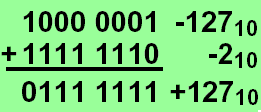
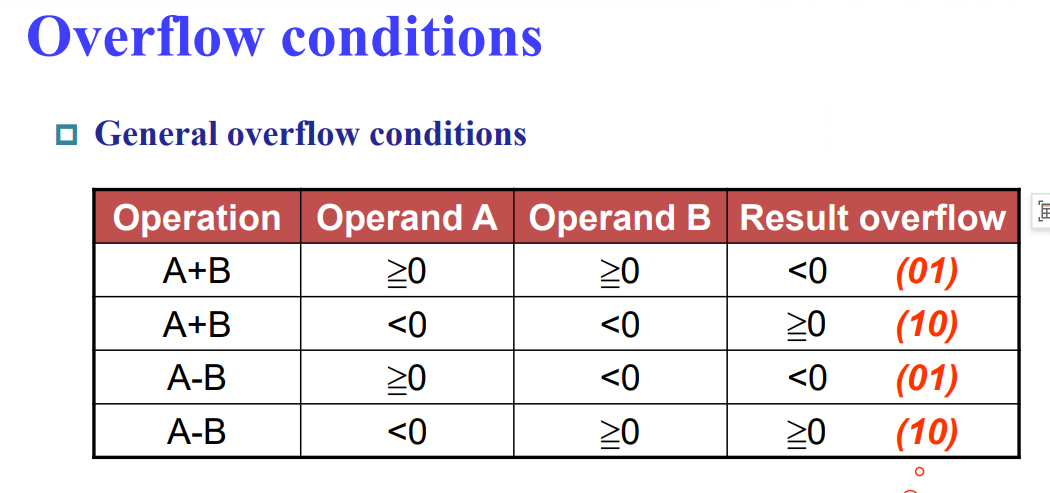
Reaction of Overflow¶
- An exception (interrupt) occurs
- Control jumps to predefined address for exception
- Interrupted address is saved for possible resumption
- Signaling to application (Ada, Fortran)
- Ignore, don't always want to detect overflow
- note:
sltu, sltiufor unsigned comparisons
Overflow process¶
- Hardware detection in the ALU
- Generation of an exception (interrupt)
- Save the instruction address (not PC) in special register SEPC
- Jump to specific routine in OS
- Correct & return to program
- Return to program with error code
- Abort program
Logical Operation¶
Logical operations¶
- Logical shift operation
- right (srl)
- left (sll)
The machine instruction for the instruction¶
- slli x11, x9, 3
Constructing an ALU¶
ALU symbol & Control¶
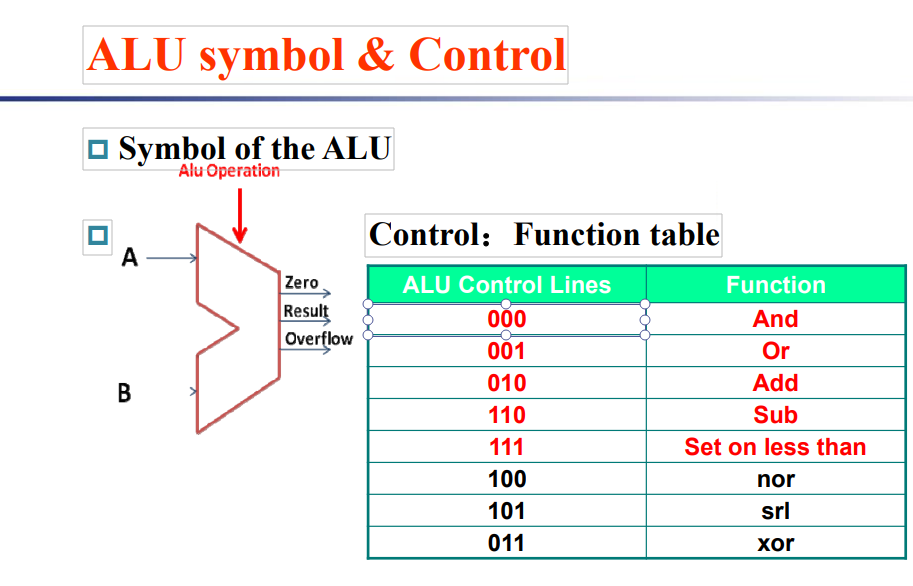
Carry skip adder(跳跃加法器)¶
- Accelerating the carry by skipping the interior blocks
- Optimal speed with no-equal distribution of block length
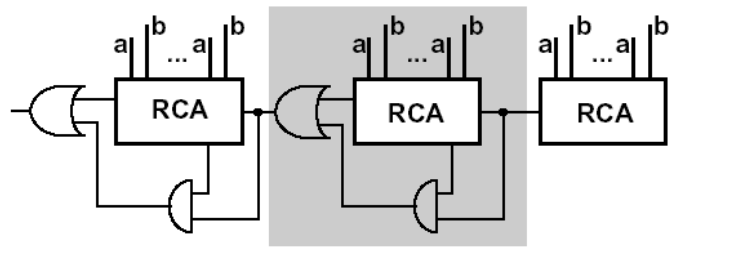
Arithmetic¶
- Substraction
- Overflow detection: \(C_n \oplus C_{n-1}\)
注: RISC-V 不支持 nor 指令。
Multiplication¶
Unsigned multiplication¶
Multiplicand (被乘数) \(\times\) Multiplier (乘数)
-
如果乘数末位是 1, 加被乘数,否则加 0. 随后将被乘数左移 1 位。

需要 128+128+64 bit 的寄存器,和一个 128 bit ALU.
-
不移被乘数,而是移积 (product). 这样 ALU 只需要 64 位。

Example

-
这里积最开始只保存在左半部分,右半部分为空。而乘数也要右移,这样我们可以把两个数拼到一起,同时右移。

Signed multiplication¶
有符号相乘不能直接乘,可以先用符号位决定结果符号,再对绝对值进行乘法。
Booth's Algorithm
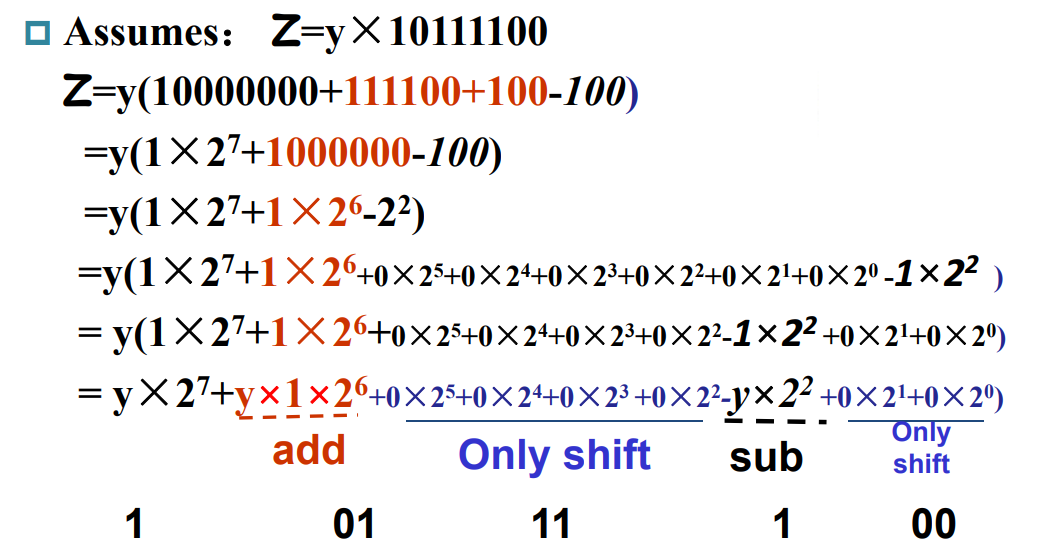
思想:如果有一串\(1\)
- 减掉乘数的第一个1
- 后面的1的序列进行移位
- 当上一步是最后一个1时加
最开始把积放在高位,被乘数放在低位。(数据保存方法同 2.1.1)默认 \(bit_{-1}=0\)
-
Action
- 10 - subtract multiplicand from left
- 11 - nop
- 01 - add multiplicand to left half
- 00 - nop
每个操作结束后都要移位,和 2.1.1 中类似
注意移位时不要改变符号位。
Example
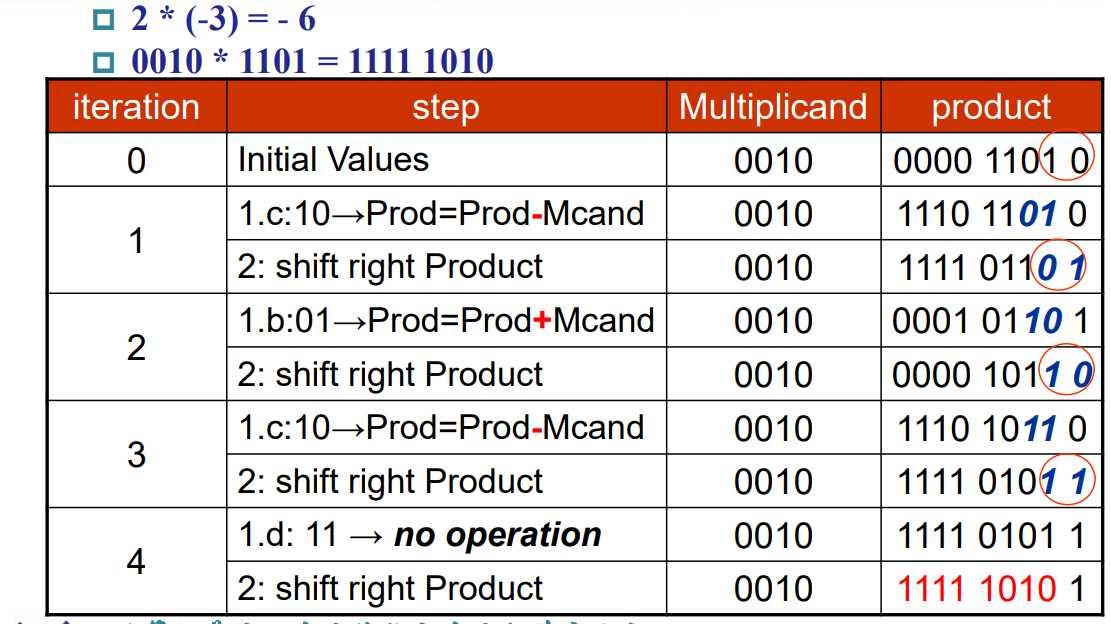
被乘数 Multiplicand 是 0010, 乘数 Multiplier 是 1101.
最开始将积 0000 放在高四位, 1101 作为乘数放在低四位。
最开始 10, 即执行减操作, \(0000-0010=1110\). 答案依然放在高四位,随后右移,以此类推。
注意右移的时候是算术右移, \(bit_{-1}\) 也可能会改变。
Faster Multiplication¶
32 位数乘 32 位数,相当于 32 个 32 位数相加。(并行加速)
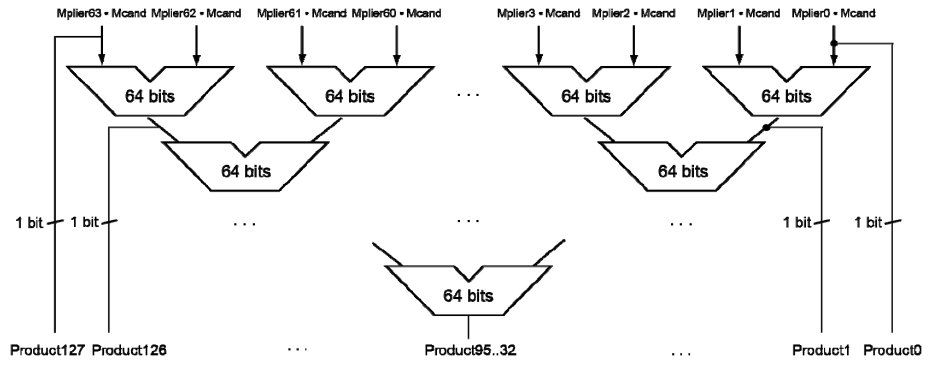
Division¶
Dividend (被除数) \(\div\) Divisor (除数)
- 将除数放到高位。从高位开始减,减完将除数右移。商也随之不断左移。如果减完之后是负数,需要还回去。
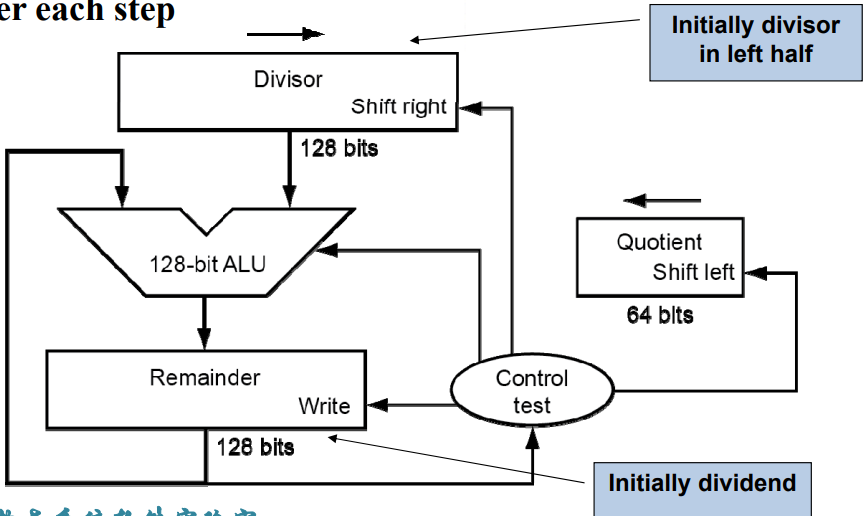
7÷2
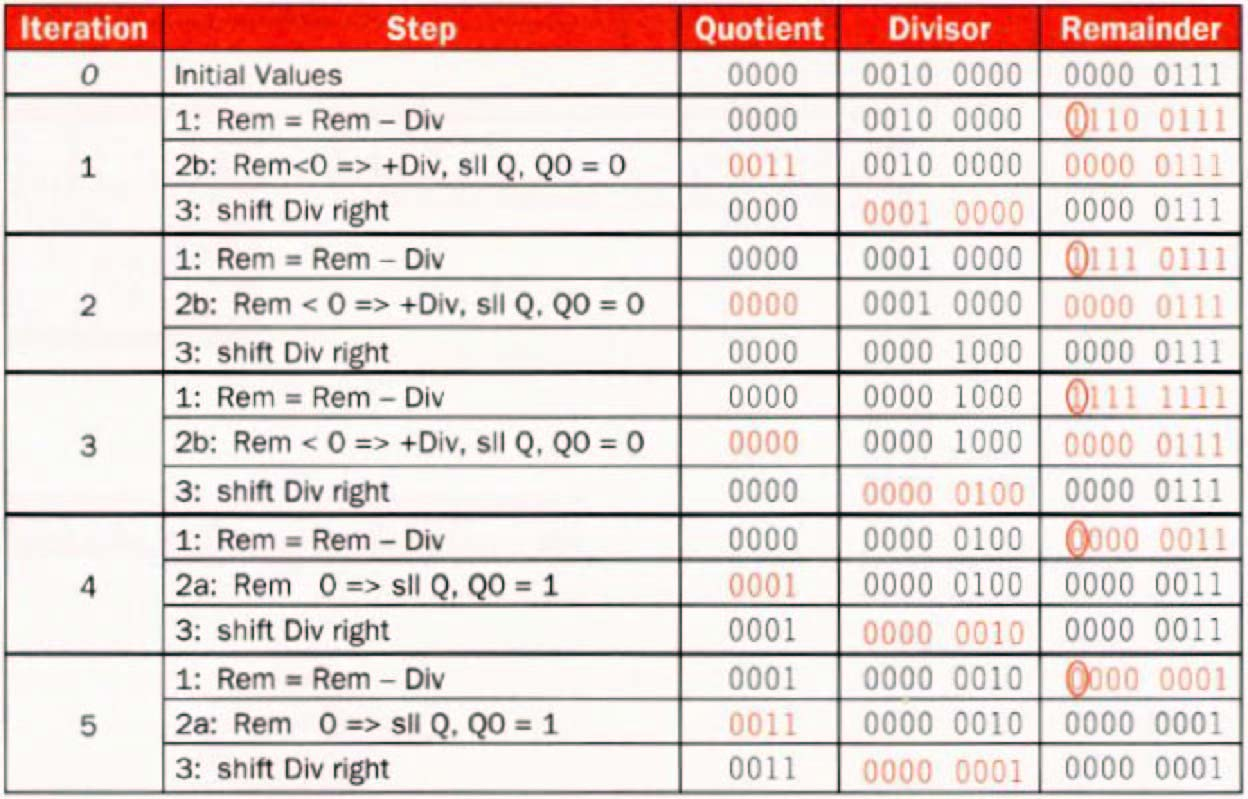
- 除数不动,被除数不停地往左移。减到最后一次,如果是小于 0 的,说明不用减了,剩下的就是余数,需要右移移回来。(即将左半部分右移一位)因为每次都是将除数和被除数最高位减,减了之后高位就没用了,可以移出去。
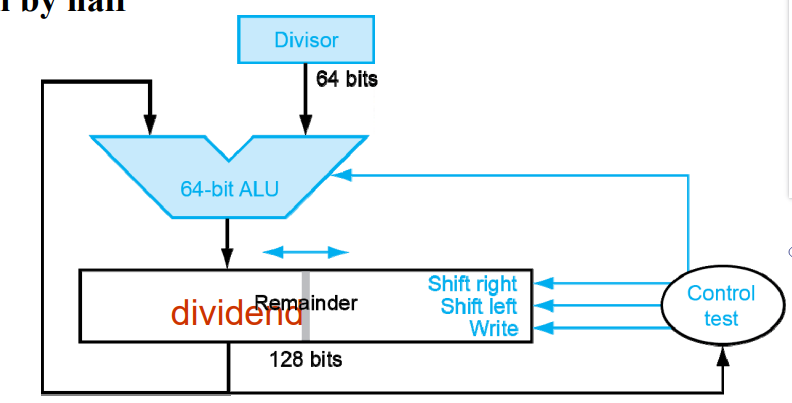
实际上这里结果是 129 位,防止 carry 丢失
Example
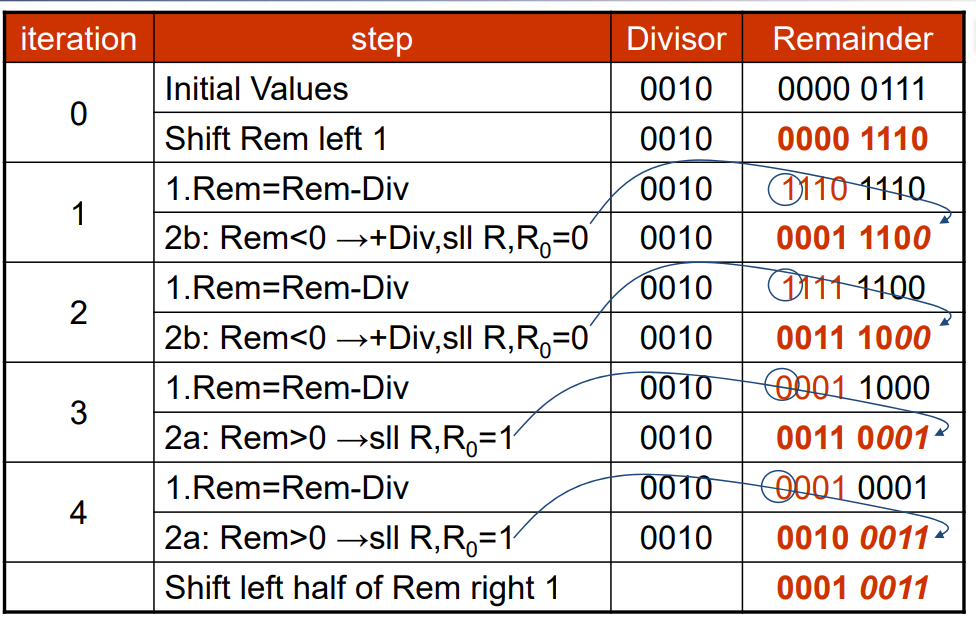 这里最开始余数就是整个被除数。
这里最开始余数就是整个被除数。
类似乘法,这里的除数只和被除数的高位相减。如果减出来是负数,需要加回去。每次减完之后先左移,然后最右边的一位放商。4.1 时其实我们已经结束了除法操作,此时的高位就是我们的余数,但是这最后一次的结果还没有放回到 Reminder 中,因此我们需要再往左移一位为商留出空间,放入后,再把高位余数往右移动以抵消影响。
signed division¶
- 带符号的除法:要求余数和被除数符号相同。
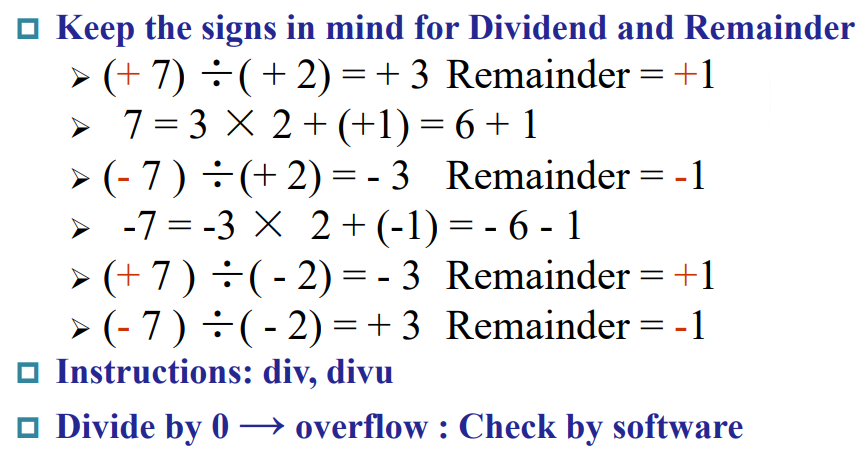
- 除零会产生溢出,由软件检测。
RISC-V Division¶
- Four instructions:
- div, rem: signed divide, remainder
- divu, remu: unsigned divide, remainder
- Overflow and division-by-zero don’t produce errors
- Just return defined results
- Faster for the common case of no error
Float¶
- Reasoning
- Larger number range than integer rage
- Fractions
- Numbers like e (2.71828) and π(3.14159265....)
- Representation for non-integral numbers
- Including very small and very large numbers
- Like scientific notation
- \(–2.34 × 10^{56}\)规范的科学计数法
- \(+0.002 × 10^{–4}\)首位为0
- \(+987.02 × 10^{9}\)
IEEE Floating-Point Format¶
- S: sign bit (0 \(\rightarrow\) non-negative, 1 \(\rightarrow\) negative)
- Normalize significand: \(1.0 ≤ |\textbf{significand}| < 2.0\)
- Always has a leading pre-binary-point 1 bit, so no need to represent it explicitly (hidden bit)
- Significand is Fraction with the “1.” restored
- Exponent: excess representation: actual exponent + Bias
- Ensures exponent is unsigned
- 偏移量:Single: Bias = 127; Double: Bias = 1023
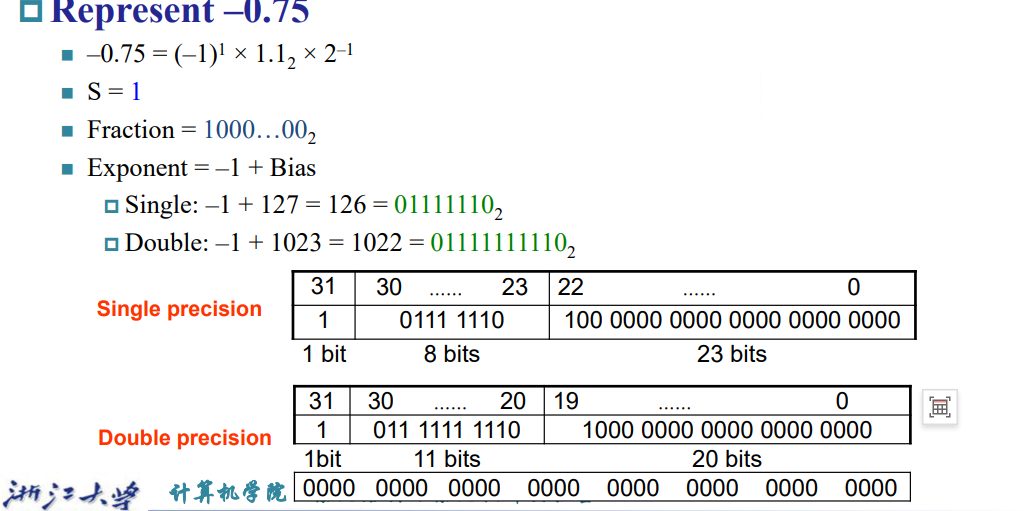
Range¶
- 单精度范围
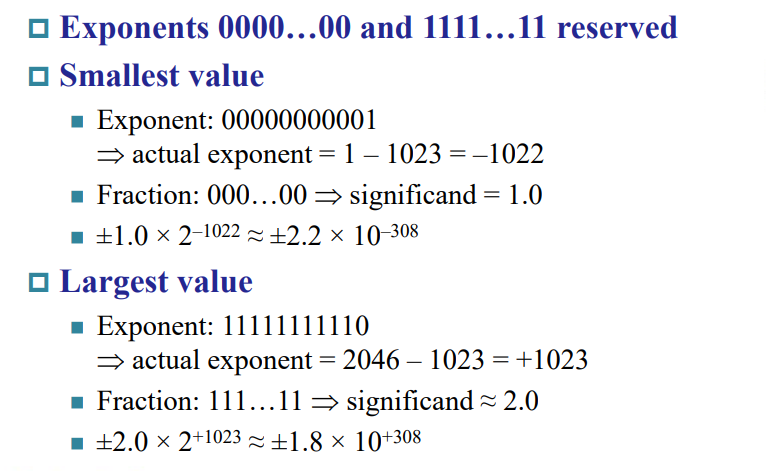
- 双精度范围
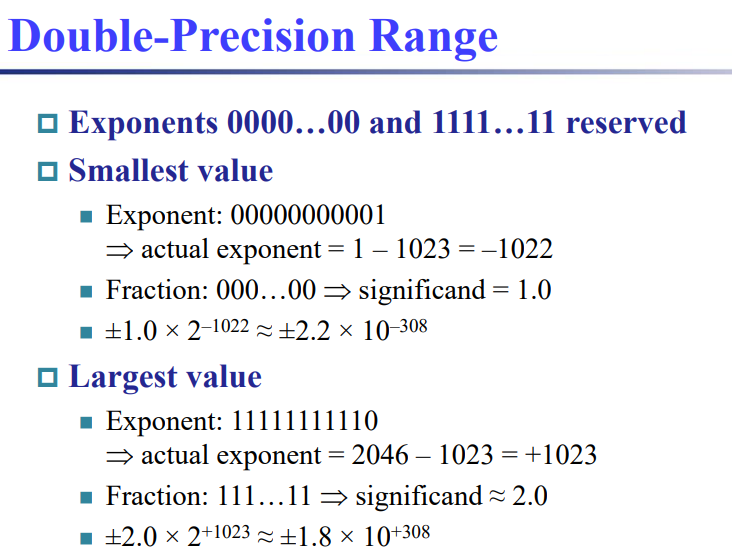
- Relative precision
- all fraction bits are significant
- Single: approx \(2^{–23}\)
- Equivalent to $23 × \log_{10}2 ≈ 23 × 0.3 ≈ 7 $decimal digits of precision
- Double: approx 2–52
- Equivalent to $52 × \log_{10}2 ≈ 52 × 0.3 ≈ 16 $decimal digits of precision
Denormal Numbers¶
- \(Exponent=000\ldots 0\)
非规格化数,让数在较小时能逐渐下溢出。
\(x=(-1)^s\times((0+Fraction)\times 2^{1-Bias})\)
注意此时指数是 \(1-Bias=-126/-1022\).- Denormal with \(Fraction = 000...0\) we define \(x=0\)
- \(Exponent=111\ldots 1, Fraction=000\ldots 0\)
表示 \(\pm \inf\) - \(Exponent=111\ldots 1, Fraction\neq 000\ldots 0\)
表示 NaN (Not-a-Number)

addition¶
将指数更小的浮点数的有效部分右移对齐(Truncation)
Example
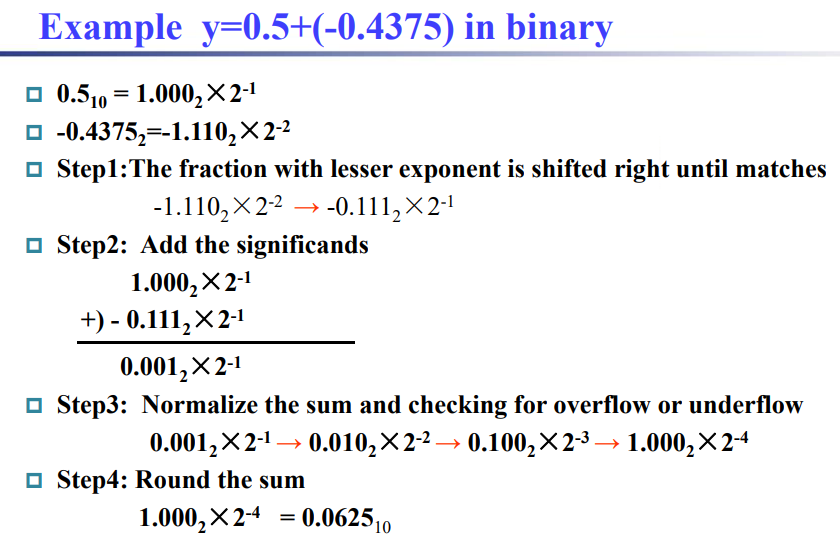
FP Adder Hardware¶

蓝色线为控制通路,黑色线为数据通路
- Much more complex than integer adder
- Doing it in one clock cycle would take too long
- Much longer than integer operations
- Slower clock would penalize all instructions
- FP adder usually takes several cycles
- Can be pipelined
Floating-Point Multiplication¶
\((s1\cdot 2^{e1}) \cdot (s2\cdot 2^{s2}) = (s1\cdot s2)\cdot 2^{e1+e2}\)
- Add exponents
- Multiply the significands
- Normalize
- Over/Underflow?
有的话要抛出异常,通过结果的指数判断。 - Rounding
- Sign
注意 Exponet 中是有 Bias 的,两个数的 exp 部分相加后还要再减去 Bias.
Example
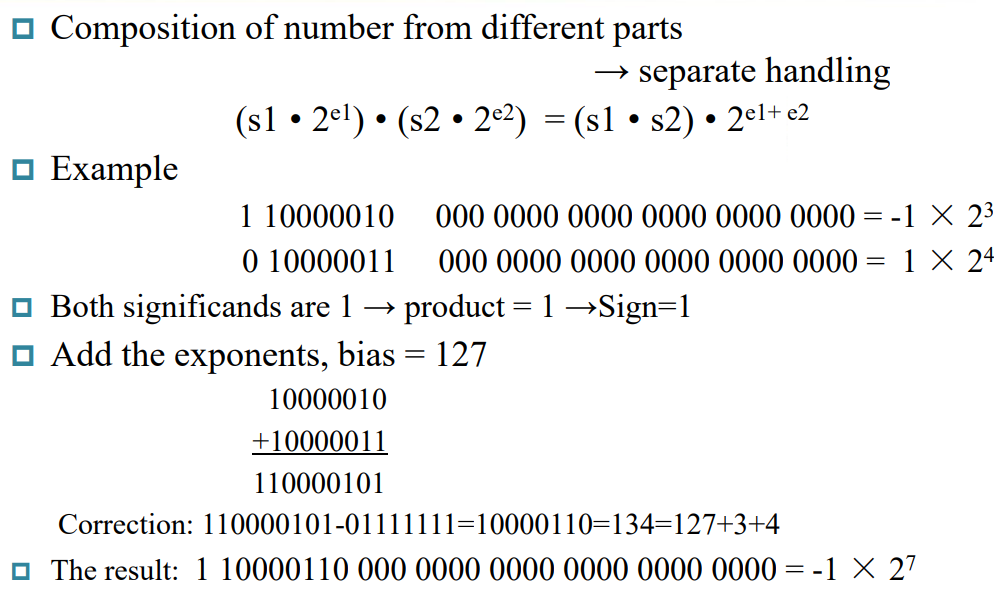
Data Flow
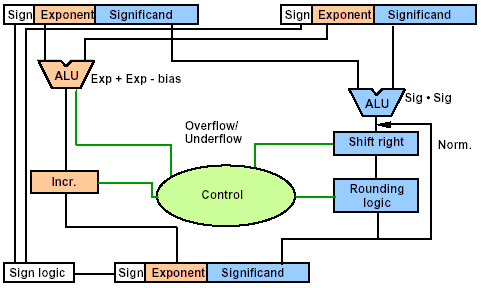
- 右边往回的箭头: Rounding 后可能会进位。
- Incr 用于标准化结果,与右侧 Shift Right 配合。
Parallelism and Computer Arithmetic: Associativity¶
- 浮点数运算受运算顺序影响
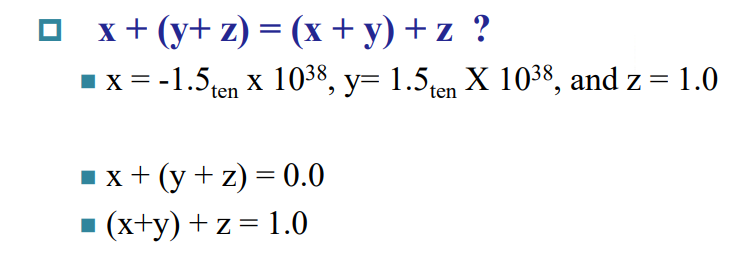
FP Instructions in RISC-V¶
- Separate FP registers: f0, …, f31
- double-precision
- single-precision values stored in the lower 32 bits
- FP instructions operate only on FP registers
- Programs generally don’t do integer ops on FP data, or vice versa
- More registers with minimal code-size impact
- FP load and store instructions
- flw, fld
- fsw, fsd
- Single-precision arithmetic
- fadd.s, fsub.s, fmul.s, fdiv.s, fsqrt.s
- e.g., fadds.s f2, f4, f6
- fadd.s, fsub.s, fmul.s, fdiv.s, fsqrt.s
- Double-precision arithmetic
- fadd.d, fsub.d, fmul.d, fdiv.d, fsqrt.d
- e.g., fadd.d f2, f4, f6
- fadd.d, fsub.d, fmul.d, fdiv.d, fsqrt.d
- Single- and double-precision comparison
- feq.s, flt.s, fle.s
- feq.d, flt.d, fle.d
- Result is 0 or 1 in integer destination register
- Use beq, bne to branch on comparison result
- Branch on FP condition code true or false
- B.cond